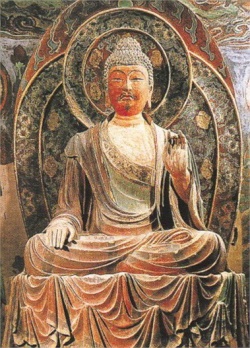Difference between revisions of "Prologue to Abhisamayalankara Commentary"
m (Text replacement - "hidden meaning" to "hidden meaning") |
|||
| Line 1: | Line 1: | ||
{{DisplayImages|1583|2869|1494|360}} | {{DisplayImages|1583|2869|1494|360}} | ||
| + | |||
| + | |||
| + | |||
| + | |||
| + | |||
| + | |||
<poem> | <poem> | ||
| − | by [[Khenchen | + | by [[Khenchen Shenga]] |
| − | All [[Dharma]] teachings are included within the [[Buddha’s | + | All [[Dharma]] teachings are included within the [[Buddha’s word]] and the treatises, |
The {{Wiki|excellent}} {{Wiki|speech}} and the commentaries on its intended meaning, | The {{Wiki|excellent}} {{Wiki|speech}} and the commentaries on its intended meaning, | ||
By means of these, the [[teaching]] of the [[Shakya]] | By means of these, the [[teaching]] of the [[Shakya]] | ||
Will remain for long within this [[world]]. | Will remain for long within this [[world]]. | ||
| − | As this says, all the {{Wiki|excellent}} teachings of the [[Dharma]] can be included within two categories: the {{Wiki|speech}} of the victorious [[Buddha]] and the treatises which provide commentaries on its intended meaning. Among these, if one is to understand the [[enlightened]] [[intention]] of | + | |
| − | the [[Buddha’s]] words correctly, one must rely on the treatises composed by valid authors. In the {{Wiki|present}} context of the [[mahayana teachings]], there were only two great pioneers who were [[able]] to comment on the [[enlightened]] intent of the victorious [[Buddha]] {{Wiki|independently}}. Both | + | |
| − | these [[masters]] thoroughly clarified both the profound and vast aspects of the teachings, but by considering where each placed greater {{Wiki|emphasis}} it is generally said that the glorious [[lord]] [[Nagarjuna]] founded the [[tradition]] of [[Profound View]] and [[noble]] [[Asanga]] the [[tradition]] of | + | As this says, all the {{Wiki|excellent}} teachings of the [[Dharma]] can be included within two categories: the {{Wiki|speech}} of the victorious [[Buddha]] and the treatises which provide commentaries on its intended meaning. |
| + | |||
| + | Among these, if one is to understand the [[enlightened]] [[intention]] of | ||
| + | the [[Buddha’s]] words correctly, one must rely on the treatises composed by valid authors. | ||
| + | |||
| + | In the {{Wiki|present}} context of the [[mahayana teachings]], there were only two great pioneers who were [[able]] to comment on the [[enlightened]] intent of the victorious [[Buddha]] {{Wiki|independently}}. | ||
| + | |||
| + | Both these [[masters]] thoroughly clarified both the profound and vast aspects of the teachings, but by considering where each placed greater {{Wiki|emphasis}} it is generally said that the glorious [[lord]] [[Nagarjuna]] founded the [[tradition]] of [[Profound View]] and [[noble]] [[Asanga]] the [[tradition]] of | ||
Extensive Conduct. | Extensive Conduct. | ||
| − | + | ||
| − | Of these, on this [[occasion]] we are concerned with the [[five treatises]] which the [[noble]] [[Asanga]] heard from the [[Buddha’s]] {{Wiki|regent}}, the great [[lord]] on the [[tenth bhumi]] [i.e., [[Maitreya]]], and then spread throughout the [[world]], teachings that were given in order to explain the intent | + | Of these, on this [[occasion]] we are concerned with the [[five treatises]] which the [[noble]] [[Asanga]] heard from the [[Buddha’s]] {{Wiki|regent}}, the great [[lord]] on the [[tenth bhumi]] [i.e., |
| − | of the entire [[mahayana]]. They are: | + | |
| − | [[ | + | [[Maitreya]]], and then spread throughout the [[world]], teachings that were given in order to explain the intent |
| + | of the entire [[mahayana]]. | ||
| + | |||
| + | They are: | ||
| + | |||
| + | The [[Ornament of Clear Realization]] ([[Abhisamayalankara]]), which explains the intent of the [[sutras]] [[teaching]] profound [[emptiness]]; | ||
| + | |||
The [[Ornament of Sutras]] ([[Sutralankara]]) and the two ‘Distinguishing’s, which explain the intent of the [[sutras]] [[teaching]] the aspect of extensive conduct; and | The [[Ornament of Sutras]] ([[Sutralankara]]) and the two ‘Distinguishing’s, which explain the intent of the [[sutras]] [[teaching]] the aspect of extensive conduct; and | ||
| + | |||
[[The Sublime Continuum]] ([[Uttaratantra]]), which explains the intent of the [[sutras]] [[teaching]] the [[inconceivable]] [[nature of reality]] ([[dharmata]]). | [[The Sublime Continuum]] ([[Uttaratantra]]), which explains the intent of the [[sutras]] [[teaching]] the [[inconceivable]] [[nature of reality]] ([[dharmata]]). | ||
| + | |||
| + | |||
Moreover, these texts were given for the [[sake]] of guiding three types of {{Wiki|individual}}: | Moreover, these texts were given for the [[sake]] of guiding three types of {{Wiki|individual}}: | ||
| + | |||
The three [[intermediate]] treatises of [[Maitreya]] were composed for those to be trained through the teachings of the [[mahayana]] [[Mind Only]] system of [[philosophy]]; | The three [[intermediate]] treatises of [[Maitreya]] were composed for those to be trained through the teachings of the [[mahayana]] [[Mind Only]] system of [[philosophy]]; | ||
| − | [[ | + | |
| − | [[ | + | The [[Ornament of Clear Realization]] was composed for those to be trained through the teachings of the [[mahayana]] [[Svatantrika system]]; and |
| + | The [[Sublime Continuum]] was composed for those to be trained through the teachings on the [[mahayana]] [[Prasangika]] system. | ||
| + | |||
| + | |||
In addition: | In addition: | ||
| − | [[The Ornament of Clear Realization]] was [[taught]] as an antidote to six mistaken [[Wikipedia:concept|concepts]]. In order to counteract [[clinging]] to [[reality]], it shows how all [[phenomena]] lack [[inherent]] [[existence]], and in order to counteract any fixation upon [[non-reality]], it presents all the stages of | + | [[The Ornament of Clear Realization]] was [[taught]] as an antidote to six mistaken [[Wikipedia:concept|concepts]]. In order to counteract [[clinging]] to [[reality]], it shows how all [[phenomena]] lack [[inherent]] [[existence]], and in order to counteract any fixation upon [[non-reality]], it presents all the stages of the [[paths]]. |
| − | the [[paths]]. | ||
| − | The three [[intermediate]] treatises such as The [[Ornament of Sutras]] were [[taught]] for those who are unable to understand certain aspects of the absence of [[extremes]]. They teach the implied and indirect meanings, the [[three natures]] and so on, in order to counteract the tendency | + | The three [[intermediate]] treatises such as The [[Ornament of Sutras]] were [[taught]] for those who are unable to understand certain aspects of the absence of [[extremes]]. |
| − | to take things too literally, and they teach the ways of engaging in an [[infinite]] variety of [[skilful means]] in order to counteract a lack of [[interest]] in the extensive aspect of the teachings and a narrow-minded wish to [[meditate]] upon [[selflessness]]. | + | |
| + | They teach the implied and indirect meanings, the [[three natures]] and so on, in order to counteract the tendency to take things too literally, and they teach the ways of engaging in an [[infinite]] variety of [[skilful means]] in order to counteract a lack of [[interest]] in the extensive aspect of the teachings and a narrow-minded wish to [[meditate]] upon [[selflessness]]. | ||
| − | The Treatise on the [[Sublime Continuum]] teaches that all [[sentient beings]] possess the [[buddha nature]] in order to counteract the [[five faults]] such as discouragement, and it gives various explanations, examples and categories of [[pure]] [[awakening]] in order to counteract the | + | The Treatise on the [[Sublime Continuum]] teaches that all [[sentient beings]] possess the [[buddha nature]] in order to counteract the [[five faults]] such as discouragement, and it gives various explanations, |
| − | [[thought]] that if this is so [i.e., if all [[beings]] have the [[buddha nature]]] then there can be no {{Wiki|decrease}} in faults and increase in qualities. | + | |
| + | examples and categories of [[pure]] [[awakening]] in order to counteract the [[thought]] that if this is so [i.e., if all [[beings]] have the [[buddha nature]]] then there can be no {{Wiki|decrease}} in faults and increase in qualities. | ||
| − | Among these treatises we are here concerned with [[The Ornament of Clear Realization]] and this is explained in terms of [[five principal considerations]]. The following questions are posed: (i) Who composed the text? (ii) From which [[scriptural]] sources does it draw? (iii) To | + | Among these treatises we are here concerned with [[The Ornament of Clear Realization]] and this is explained in terms of [[five principal considerations]]. |
| − | which category does it belong? (iv) What is its basic theme from beginning to end? and (v) For what {{Wiki|purpose}} was it composed? | + | |
| + | The following questions are posed: | ||
| + | |||
| + | (i) Who composed the text? | ||
| + | |||
| + | (ii) From which [[scriptural]] sources does it draw? | ||
| + | |||
| + | (iii) To which category does it belong? (iv) What is its basic theme from beginning to end? and (v) For what {{Wiki|purpose}} was it composed? | ||
| + | |||
(i) The Author | (i) The Author | ||
| Line 43: | Line 78: | ||
It draws from all the [[precious]] [[prajnaparamita sutras]], such as the extensive, {{Wiki|medium}} and condensed ‘mothers’ of the [[victorious ones]]. | It draws from all the [[precious]] [[prajnaparamita sutras]], such as the extensive, {{Wiki|medium}} and condensed ‘mothers’ of the [[victorious ones]]. | ||
| + | |||
(iii) Category | (iii) Category | ||
| − | Among the so-called ‘[[three turnings]]’ of the [[Buddha’s teachings]], it is a commentary on [[sutras]] such as The One [[Hundred Thousand Verse]] [[Prajnaparamita]], i.e., the [[sutras]] of [[definitive meaning]] from the [[intermediate]] ‘[[Dharma wheel]]’ on the absence of [[characteristics]]. It is an | + | |
| + | Among the so-called ‘[[three turnings]]’ of the [[Buddha’s teachings]], it is a commentary on [[sutras]] such as The One [[Hundred Thousand Verse]] [[Prajnaparamita]], i.e., | ||
| + | |||
| + | the [[sutras]] of [[definitive meaning]] from the [[intermediate]] ‘[[Dharma wheel]]’ on the absence of [[characteristics]]. It is an | ||
[[essential]] instruction [[teaching]] profound [[emptiness]]. | [[essential]] instruction [[teaching]] profound [[emptiness]]. | ||
| Line 54: | Line 93: | ||
(v) Purpose | (v) Purpose | ||
| − | This treatise was composed in order to [[guide]] [[beings]] who are confused as to how the various stages of realization—the hidden meaning of the Mother | + | This treatise was composed in order to [[guide]] [[beings]] who are confused as to how the various stages of realization—the hidden meaning of the Mother [[Prajnaparamita]]—are to be taken into practice. |
| − | One might ask which commentary one should follow when explaining this treatise. In response to this it should be related how, when [[Acharya]] [[Haribhadra]] was about to teach the [[prajnaparamita]] with a [[view]] to benefitting [[beings]], he grew disheartened upon [[seeing]] that the | + | One might ask which commentary one should follow when explaining this treatise. |
| − | various texts made differing assertions and explanations given by different [[teachers]] disagreed with one another. While he was still in a [[state]] of extreme [[despondency]], the [[lord]] of [[great compassion]], [[Maitreya]], appeared before him and, in order to clear away his [[sadness]], | + | |
| − | [[taught]] him the [[Bhagavati]] [[Prajnaparamita]] including the clear realizations. He then composed his commentary to the [[essential]] instructions on the [[prajnaparamita]] according to the explanation he received from [[noble]] [[Maitreya]]. | + | In response to this it should be related how, when [[Acharya]] [[Haribhadra]] was about to teach the [[prajnaparamita]] with a [[view]] to benefitting [[beings]], he grew disheartened upon [[seeing]] that the various texts made differing assertions and explanations given by different [[teachers]] disagreed with one another. |
| + | |||
| + | While he was still in a [[state]] of extreme [[despondency]], the [[lord]] of [[great compassion]], [[Maitreya]], appeared before him and, in order to clear away his [[sadness]], [[taught]] him the [[Bhagavati]] [[Prajnaparamita]] [[including]] the clear realizations. | ||
| + | |||
| + | He then composed his commentary to the [[essential]] instructions on the [[prajnaparamita]] according to the explanation he received from [[noble]] [[Maitreya]]. | ||
It is therefore the commentary composed by this [[master]], [[Clarifying the Meaning]], which will now be explained, beginning with the meaning of its title. | It is therefore the commentary composed by this [[master]], [[Clarifying the Meaning]], which will now be explained, beginning with the meaning of its title. | ||
Revision as of 05:17, 4 March 2016
by Khenchen Shenga
All Dharma teachings are included within the Buddha’s word and the treatises,
The excellent speech and the commentaries on its intended meaning,
By means of these, the teaching of the Shakya
Will remain for long within this world.
As this says, all the excellent teachings of the Dharma can be included within two categories: the speech of the victorious Buddha and the treatises which provide commentaries on its intended meaning.
Among these, if one is to understand the enlightened intention of
the Buddha’s words correctly, one must rely on the treatises composed by valid authors.
In the present context of the mahayana teachings, there were only two great pioneers who were able to comment on the enlightened intent of the victorious Buddha independently.
Both these masters thoroughly clarified both the profound and vast aspects of the teachings, but by considering where each placed greater emphasis it is generally said that the glorious lord Nagarjuna founded the tradition of Profound View and noble Asanga the tradition of
Extensive Conduct.
Of these, on this occasion we are concerned with the five treatises which the noble Asanga heard from the Buddha’s regent, the great lord on the tenth bhumi [i.e.,
Maitreya], and then spread throughout the world, teachings that were given in order to explain the intent
of the entire mahayana.
They are:
The Ornament of Clear Realization (Abhisamayalankara), which explains the intent of the sutras teaching profound emptiness;
The Ornament of Sutras (Sutralankara) and the two ‘Distinguishing’s, which explain the intent of the sutras teaching the aspect of extensive conduct; and
The Sublime Continuum (Uttaratantra), which explains the intent of the sutras teaching the inconceivable nature of reality (dharmata).
Moreover, these texts were given for the sake of guiding three types of individual:
The three intermediate treatises of Maitreya were composed for those to be trained through the teachings of the mahayana Mind Only system of philosophy;
The Ornament of Clear Realization was composed for those to be trained through the teachings of the mahayana Svatantrika system; and
The Sublime Continuum was composed for those to be trained through the teachings on the mahayana Prasangika system.
In addition:
The Ornament of Clear Realization was taught as an antidote to six mistaken concepts. In order to counteract clinging to reality, it shows how all phenomena lack inherent existence, and in order to counteract any fixation upon non-reality, it presents all the stages of the paths.
The three intermediate treatises such as The Ornament of Sutras were taught for those who are unable to understand certain aspects of the absence of extremes.
They teach the implied and indirect meanings, the three natures and so on, in order to counteract the tendency to take things too literally, and they teach the ways of engaging in an infinite variety of skilful means in order to counteract a lack of interest in the extensive aspect of the teachings and a narrow-minded wish to meditate upon selflessness.
The Treatise on the Sublime Continuum teaches that all sentient beings possess the buddha nature in order to counteract the five faults such as discouragement, and it gives various explanations,
examples and categories of pure awakening in order to counteract the thought that if this is so [i.e., if all beings have the buddha nature] then there can be no decrease in faults and increase in qualities.
Among these treatises we are here concerned with The Ornament of Clear Realization and this is explained in terms of five principal considerations.
The following questions are posed:
(i) Who composed the text?
(ii) From which scriptural sources does it draw?
(iii) To which category does it belong? (iv) What is its basic theme from beginning to end? and (v) For what purpose was it composed?
(i) The Author
The text was composed by Noble Maitreya, a bodhisattva who has trained in a vast, ocean-like gathering of the two accumulations for thirty-three incalculable aeons, and is now at the end of the tenth bhumi, just a single birth away from buddhahood.
(ii) Scriptural Sources
It draws from all the precious prajnaparamita sutras, such as the extensive, medium and condensed ‘mothers’ of the victorious ones.
(iii) Category
Among the so-called ‘three turnings’ of the Buddha’s teachings, it is a commentary on sutras such as The One Hundred Thousand Verse Prajnaparamita, i.e.,
the sutras of definitive meaning from the intermediate ‘Dharma wheel’ on the absence of characteristics. It is an
essential instruction teaching profound emptiness.
(iv) Theme from Beginning to End
It is summarized in terms of seventy points, from the generation of bodhichitta through to the dharmakaya, all of which are included within eight topics: the three knowledges to be understood, the four applications to be practised, and the result, the dharmakaya.
(v) Purpose
This treatise was composed in order to guide beings who are confused as to how the various stages of realization—the hidden meaning of the Mother Prajnaparamita—are to be taken into practice.
One might ask which commentary one should follow when explaining this treatise.
In response to this it should be related how, when Acharya Haribhadra was about to teach the prajnaparamita with a view to benefitting beings, he grew disheartened upon seeing that the various texts made differing assertions and explanations given by different teachers disagreed with one another.
While he was still in a state of extreme despondency, the lord of great compassion, Maitreya, appeared before him and, in order to clear away his sadness, taught him the Bhagavati Prajnaparamita including the clear realizations.
He then composed his commentary to the essential instructions on the prajnaparamita according to the explanation he received from noble Maitreya.
It is therefore the commentary composed by this master, Clarifying the Meaning, which will now be explained, beginning with the meaning of its title.



